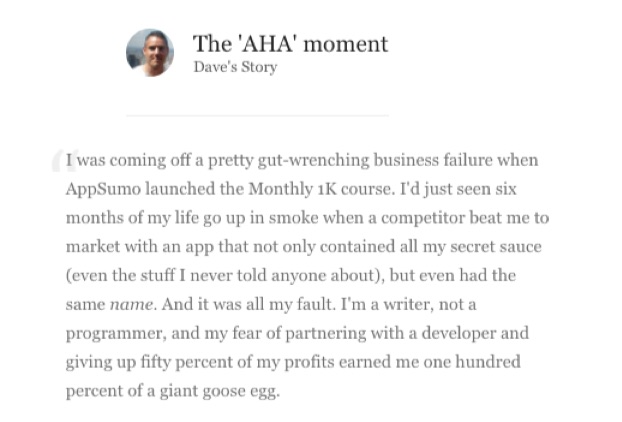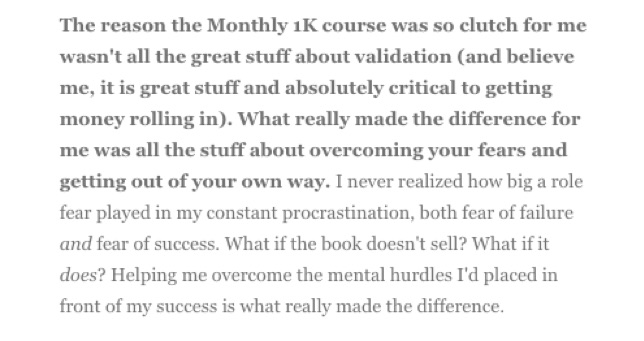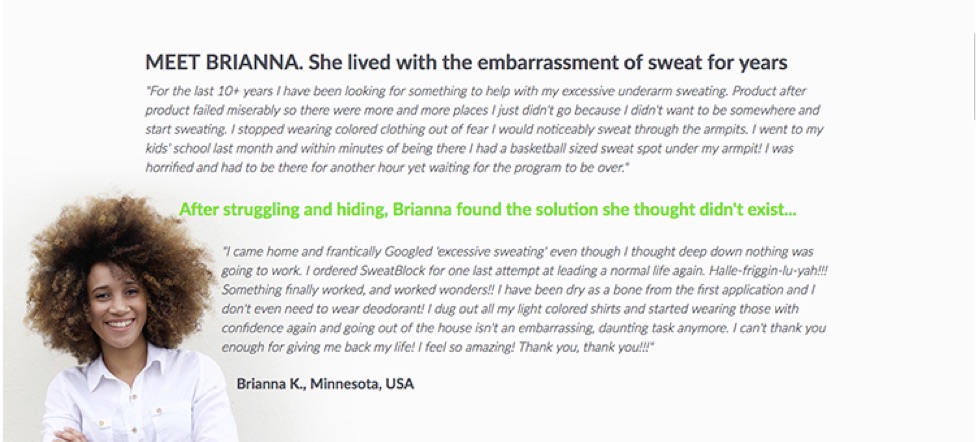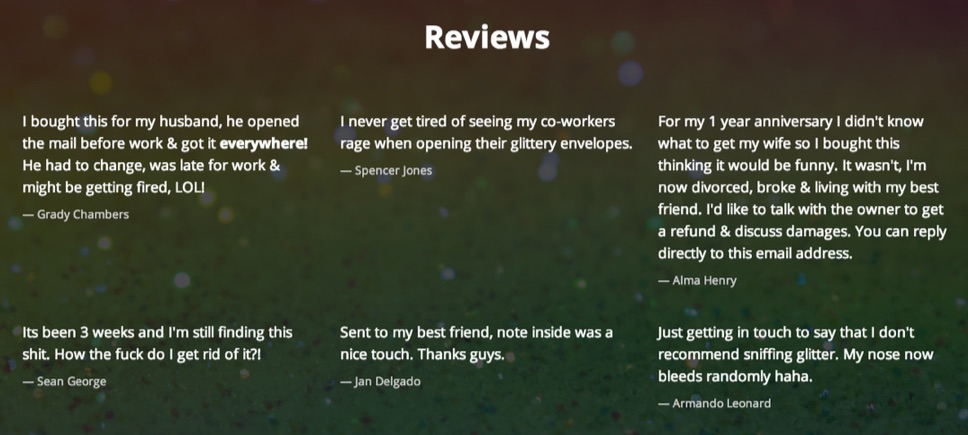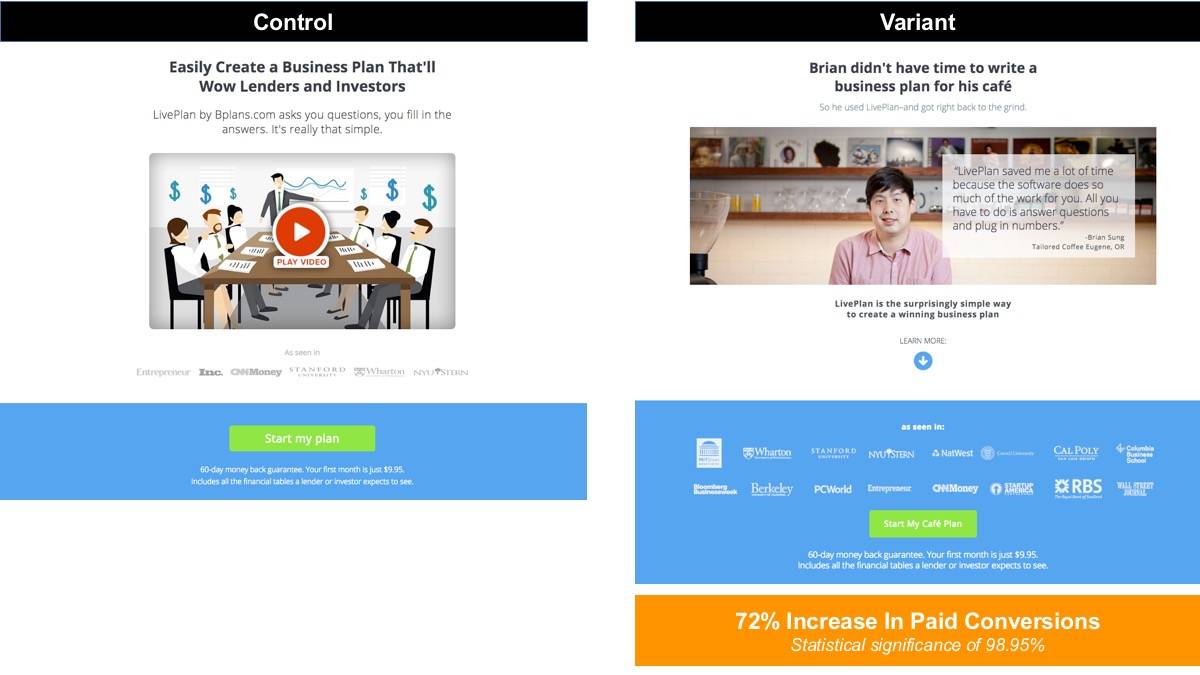Tuesday, 28 February 2017
Snap: Rewriting ‘Art of War’ for social networking — by not documenting anything
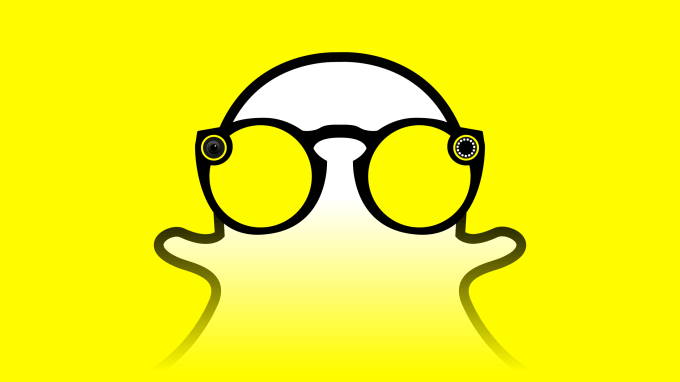 Social networks may be the most valuable and durable types of businesses powered by “network effects,” the phenomenon of products or services becoming more powerful the more people use them. This is one reason the imminent IPO of social/mobile app Snap, which thrives on network effects, is being so closely watched. Another is that Snap represents the first credible threat to Facebook. Read More
Social networks may be the most valuable and durable types of businesses powered by “network effects,” the phenomenon of products or services becoming more powerful the more people use them. This is one reason the imminent IPO of social/mobile app Snap, which thrives on network effects, is being so closely watched. Another is that Snap represents the first credible threat to Facebook. Read Moresource https://techcrunch.com/2017/02/28/snap-rewriting-art-of-war-for-social-networking-by-not-documenting-anything/?ncid=rss
3 Unusual Tactics For Making Your Testimonials More Persuasive
I bet you’ve seen this sort of advice before…
When using a testimonial, you should always:
- List the customer’s first and last name
- Include their photo
- Avoid unbelievable, over-the-top praise
Those are all fine tips to follow, but they’re really just starting points.
Optimizing your social proof requires just as much strategy and testing as improving a headline, hero image or call-to-action button.
Because if you just stick to blindly following ‘best practices,’ you could be missing out on a huge opportunity to squeeze more conversions out of your website or landing page. Here’s why:
Social proof affects different audiences in different ways. The complexity of your offer, the demographics of your visitors and a host of other factors all influence how persuasive your testimonials will be.
And that means you may want to try optimizing them in ways that seem counterintuitive at first.
Or even just plain strange.
I’ll get into more detail about this in a moment. But first, let’s make sure we’re on the same page about what typically makes for a convincing and credible testimonial.
Don’t use testimonials unless you’ve seen these tips…
Plenty of articles have already been written offering great advice for using testimonials. And those tips can generally be summed up as:
- Include a photo and other details
Providing the customer’s first and last name, location or any other relevant details makes testimonials more realistic. But an even bigger factor is including a (real) photo of the testimonial-giver. There’s plenty of research to back this up. - Use testimonials from people your customers can relate to
According to implicit egotism theory, we generally trust people who are either like us or who we aspire to be like. And that means strong testimonials are often from folks who reflect how your prospects see themselves. - Use testimonials from people with authority (if possible)
The most powerful testimonials come from people your audience sees as an expert or otherwise having authority. In essence, you’re ‘borrowing’ the positive feelings people have toward these individuals (this is called the Halo Effect) when you get their endorsement. - Reinforce a specific benefit
Emphasis on specific. Vague testimonials that say things like “great experience” or “tremendous value” won’t connect with anyone. And it might even hurt your conversion rate. Instead, testimonials should be used strategically as ‘proof’ to support specific claims you’re making on your pages. -
OR
- Quash a serious objection
Research by MECLABS shows that placing testimonials near sources of anxiety (such as the ‘Add to Cart’ button) can ease objections and improve conversions. Bottom line: don’t just randomly sprinkle testimonials throughout your website. First, consider the role they’re playing on the page.
These tips make sense, right?
And if you’ve been in the conversion optimization game for any length of time, I suspect you’re already familiar with most of them.
Now, let’s dive into 3 lesser-known techniques for making your testimonials more credible, engaging and persuasive.
1) Try ‘long-form’ testimonials
Far too many articles give out generic advice like:
“Always keep your testimonials very short.”
Well, no. Not always.
Short, specific quotes from customers may work fine in certain situations. But sometimes a big, juicy testimonial can provide the exact dose of social proof that your page needs. Why?
For the same reasons that long copy can sometimes be more persuasive than short copy. Long-form sales messages often work great when your product is complicated, your audience has loads of objections or the price-tag is high.
As veteran ad man Jay Conrad Levinson puts it:
“Don’t be afraid to use lengthy copy. Of all the things people dislike about marketing, ‘lack of information’ comes in second, after ‘feeling deceived.’”
The trick is to ensure your long-form copy — or long-form testimonial — is interesting and relevant to your audience. Here’s an example:
Long-form testimonials make up the majority of content on Noah Kagan’s sales page for his How To Make A $1,000 A Month Business course. And some of them run well over 500 words!
Now, these testimonials work like sales copy in a number of different ways. But I want to point out one specific technique that makes them so effective: storytelling.
Several testimonials on the page tell raw, human stories about a problem the person was up against and how they discovered a life-changing solution thanks to Kagan’s course.
Take a look at this example:
Dave’s story kicks off with an emotional (and relatable) problem.
He then goes on to tell a story about how the course helped him, eventually building to the ‘climax’ detailing how his life changed afterwards:
In fact, some of the most effective long-form testimonials start with an emotional problem.
Here’s a prime example from the Sweat Block homepage, which was optimized by the team at Copy Hackers. This testimonial follows the tried-and-true problem-agitate-solve copywriting formula:
Now, a customer probably isn’t going to just hand you over a problem-agitate-solve testimonial by fluke. You may need to give them some guidance first.
So ask specific questions when requesting a testimonial. Things like:
- What made you seek out our product/service?
- What was the exact problem you needed to solve? How did it impact your life?
- How did our product/service solve this problem? How did it improve your [business/social life etc.]?
But even if you don’t take a problem-focused approach, the key to using effective long-form testimonials is to make sure they tell a gripping story.
One that will resonate with your target audience in a powerful way.
2) Show your warts (really, it’s OK)
Don’t get me wrong: I’m not saying you should post a testimonial that outright bashes your company.
That’d be weird. And, well, kind of dumb.
But I am suggesting that by leaving some minor ‘warts’ in your testimonials you can convey trust and credibility — if you do it the right way.
One study found that 68% of consumers trust reviews more when they see both positive and negative scores. And a whopping 30% suspect faked reviews when they don’t see anything negative at all.
As master copywriter Bob Bly puts it, “showing your warts” can be an effective marketing technique provided you:
- demonstrate why your product’s weakness isn’t important or
- show how you’ve designed your product to overcome the weakness
This tactic works because arguing against your own self-interest builds credibility.
In this Unbounce article, marketer and entrepreneur Pratik Dholakiya suggests testing a landing page testimonial that tells people who your product isn’t right for. This might involve including a line like:
“This product isn’t for [so and so], it’s for [so and so].”
The beauty of this approach is that it sends the message you want happy, long-term customers; not just quicks sales for short-term gain.
Some brands have used not-so-shiny testimonials in more creative ways to reinforce a key message.
For example, Ship Your Enemies Glitter used to feature a reviews section that told an unfiltered story about their product — one testimonial even mentioned a customer’s pending divorce.
OK, this is an extreme example.
The point is that people are skeptical of both online reviews and testimonials. But by slipping in a few “warts” (in a strategic way), you can give your social proof a shot of credibility.
3) Make your testimonial the ‘hero’
Got a beauty of a testimonial?
One that’s credible, relatable and aligns perfectly with the goal of your page?
Then don’t bury it way below the fold! Instead, play that sucker up big time in the hero section for every visitor to see.
Emphasizing the right testimonial immediately sends the message to prospects that your product solves problems for people who are just like them.
I used this strategy while optimizing a key sales page for LivePlan, which is a SaaS product that helps entrepreneurs write professional business plans.
Research showed us that many prospects had niggling doubts when they hit the page. They often wondered:
“Will this software work for my specific industry?”
It was a big barrier to signing up.
So we created a landing page that targeted just a segment of LivePlan’s traffic: people who wanted to write a business plan specifically for a café.
But instead of us telling the audience “this works for café entrepreneurs like you,” we wanted to prove it to them by making a relatable testimonial the hero of the page.
So we emphasized a quick story about how café owner Brian Sung used LivePlan to write a business plan faster and with less effort. Then we A/B tested the new page.
Here are the two hero sections we tested:
The testimonial-focused variant hauled in a 72% boost in paid conversions, which translated into a 53% increase in revenue (when you consider average order value).
There were a few other variables at play here. But ultimately, I believe that this relatable testimonial proved the hypothesis that LivePlan customers needed to feel confident that the product would work for their industry before signing up.
Other companies have also seen ‘wins’ by playing up testimonials like this as well. For example, Highrise saw a 102% lift in conversions when they tested a giant image and quote from one of their customers.
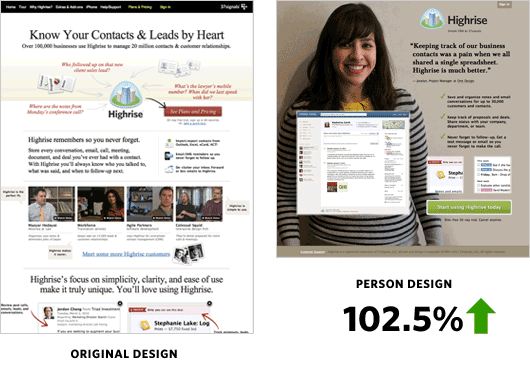
But again, having the right testimonials is key here. You can’t just pick one at random.
If you know headlines focused on “saving time” convert well, playing up a testimonial about how a customer “saved money” isn’t going to cut it.
Consider your goals and strategy for the page. Then select your social proof accordingly.
Conclusion
It doesn’t matter if you’re dealing with testimonials, user-reviews or client logos — the bottom line is the same:
Social proof affects different audiences in different ways.
Following best practices is a great starting point. But to squeeze the most persuasive value out of your testimonials, you need to consider things like your audience’s level of awareness and their thought sequence as they hit your page.
Now, maybe the 3 tactics outlined here aren’t a great fit for your prospects. That’s fine.
But it is important that you make an informed, strategic decision about how you use any type of social proof.
Because just tossing testimonials randomly on a page isn’t doing your visitors — or your conversion rates — any good.
About the author: Dustin Walker is a copywriter and partner at Good Funnel — a marketing agency that does in-depth customer research to help online businesses fire up their revenue. Follow Dustin on Twitter @dustinjaywalker.
source https://blog.kissmetrics.com/making-testimonials-more-persuasive/
eMarketer: Snapchat growth driven by older users, as usage among young adults declines
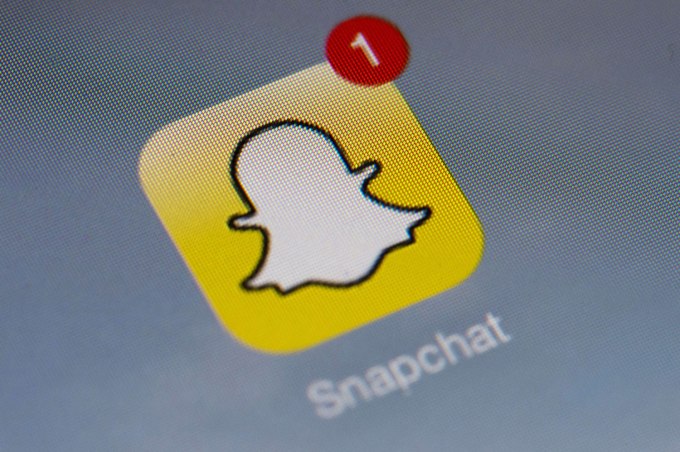 Snapchat has a reputation for being an app that’s confusing to the “olds” – something the company tried to address with a redesign just ahead of filing for its IPO. In addition, the app has expanded beyond its original use case, which focused on communication, and now includes short, easily digestible content from a number of sources, including media and… Read More
Snapchat has a reputation for being an app that’s confusing to the “olds” – something the company tried to address with a redesign just ahead of filing for its IPO. In addition, the app has expanded beyond its original use case, which focused on communication, and now includes short, easily digestible content from a number of sources, including media and… Read Moresource https://techcrunch.com/2017/02/28/emarketer-snapchat-growth-driven-by-older-users-as-usage-among-young-adults-declines/?ncid=rss
We Analyzed 1.3 Million YouTube Videos. Here’s What We Learned About YouTube SEO

We analyzed 1.3 million YouTube videos to better understand how YouTube’s search engine works.
Specifically, we looked at the correlation between ranking factors — like views, comments and shares — with YouTube rankings.
We learned a lot about YouTube SEO. And I’m sure you will too.
Here is a Summary of What We Discovered:
1. Comments appear to be an influential ranking factor. We found that a video’s comment count strongly correlates with higher rankings.
2. Longer videos significantly outperform shorter videos. The average length of a first page YouTube video is 14 minutes, 50 seconds.
3. We discovered that video views have a significant correlation with rankings.
4. The number of shares a video generates is strongly tied to first page YouTube rankings.
5. There’s a moderate correlation between a channel’s subscriber size and rankings. This means that even small channels have a chance to rank their videos in YouTube.
6. Video likes are significantly correlated with higher rankings.
7. “Subscriptions driven” has reasonably strong correlation with rankings. Therefore, videos that result in new subscribers have an advantage in YouTube search.
8. We found a very small relationship between keyword-rich video tags and rankings. This could represent the fact that YouTube can now understand video content without the help of metadata.
9. Videos that contain an exact match keyword in their video title appear to have a slight edge over videos that don’t. This means that including a keyword in your title may improve your rankings by a slim margin.
10. We found zero correlation between keyword-optimized video descriptions and rankings.
11. HD videos dominate YouTube’s search results. 68.2% of videos on the first page of YouTube are in HD.
I have detailed data and information of our findings below.
Video Comments Have a Very Strong Correlation With Rankings
YouTube encourages creators to publish videos that maximize engagement. Needless to say, comments are a strong indicator that people are engaging with your video.
But does YouTube use comments as a ranking signal?
Our data suggests that they do:

As you can see in the chart above, the more comments a video has, the higher it tends to rank. Considering YouTube’s emphasis on user engagement, this result isn’t a big surprise.
Key Takeaway: Videos with lots of comments tend to rank best in YouTube.
Longer Videos Outrank Short Videos
When it comes to video SEO, should you create short videos? Or are you better off with longer videos that cover a topic in-depth?
We analyzed our data to find out.
Our data shows that longer videos tend to significantly outrank short videos.

In fact, the average length of a video ranking on the first page of YouTube is 14 minutes, 50 seconds.
What’s happening here?
YouTube has publicly confirmed that a video’s total watch time is a key ranking signal.

Also, in 2015, Google was granted a patent for an algorithm that uses “watch time” as a ranking signal.
In short, YouTube wants to promote videos that keep people on YouTube for a long period of time. Longer videos accomplish this best, hence the preference for longer video content.
Another theory is that longer videos provide more overall value in a single video. This is true for “how-to” videos as well as for content designed to entertain. The value that longer videos provide may encourage more interaction signals (including comments and likes) that ultimately impact rankings.
In fact, if you do a cursory search of popular keywords, you’d be hard pressed to find a short video (< 3 minutes) ranking highly in the search results.

Key Takeaway: Longer videos perform best in YouTube search. The average video on the first page of YouTube’s search results is 14 minutes, 50 seconds long.
Video Shares Are Strongly Tied to Higher Rankings
Google has consistently denied the fact that social signals play a role in their algorithm.
However, YouTube’s algorithm works independently of Google. So there’s a possibility that YouTube uses shares from social media networks like Facebook, Twitter and LinkedIn as a ranking factor.
In fact, we did find that shares have a strong correlation with higher rankings in YouTube:

It’s important to note that we used YouTube’s public share report for this analysis.

Why is this important?
One of the major issues of using social shares as a ranking signal is that they’re easily gamed. Anyone can can hand someone a few dollars in exchange for sharing a piece of content 100 times on Facebook.
This isn’t the case on YouTube.
Unlike sharing content using a webpage’s social sharing icons, YouTube knows which users share video content…and where they share.
This tracking makes this signal much harder to game.
Combine that with the fact that YouTube encourages publishers to create highly-shareable content (and that YouTube reports shares in YouTube Analytics), and you have a strong possibility that the relationship between shares and rankings is more than a chance correlation.
Key Takeaway: Highly-shared videos outrank videos with fewer shares.
A Video’s View Count Is Significantly Correlated With Rankings
Video views used to be YouTube’s #1 ranking factor.
The thought was that: lots of views=popular video=quality video.
However, YouTube discovered that views often serve as a poor indicator of video quality.
So they changed their algorithm to emphasize factors like audience retention and engagement:

However, we discovered that a video’s total view count continues to have a significant correlation with rankings.

It appears that you still need a critical mass of views to rank in YouTube. (In fact a YouTube engineer stated that, while views aren’t as important as they once were, YouTube still uses them).
That’s because, without views, your video can’t generate the other signals that YouTube uses to evaluate your video’s quality (like total watch time and comments).
But at a certain point, views have diminishing returns.
That’s why you often see high-quality videos rank above lower-quality videos (even when the lower-quality video has significantly more views).

Key Takeaway: Video views are significantly correlated with higher YouTube rankings.
A Channel’s Subscriber Count Is Moderately Correlated With Rankings
We found a moderate correlation between a channel’s total subscribers and rankings:

This is good news if you run a small or new channel.
Unlike Google, which seems to have a preference for big brands, YouTube is more likely to rank content from “the little guy”.
For example, for this popular keyword, videos from two small channels outrank a video from a channel that has over 2 million subscribers:

This type of result isn’t uncommon on YouTube.
(Of course, channels with millions of subscribers have an edge. But our data shows that this advantage isn’t as significant as you may think).
Key Takeaway: Channels with lots of subscribers have an advantage in YouTube. However, videos from smaller channels consistently outrank videos from popular channels.
Videos With Lots of Likes Outrank Videos With Fewer Likes
It’s no secret that YouTube prefers videos that engage their audience.
And video “likes” serve as a powerful engagement signal. After all, likes are a crowdsourced way of evaluating how the YouTube community feels about your video.
That’s the theory. But what does the data say?
Our study revealed a significant correlation between likes and video rankings:

This suggests that YouTube may use likes as a ranking signal.
However, as you know, correlation doesn’t always mean causation.
Videos with lots of likes are also likely to be high-quality. And high-quality videos generate other ranking signals (like audience retention) that YouTube values.
Key Takeaway: YouTube may use likes as a direct ranking factor. Or it could be that heavily-liked videos generate other signals that YouTube truly cares about.
Videos That Result in New Channel Subscribers Rank Higher Than Videos That Don’t Generate Subscribers
If someone really enjoys a video on YouTube, what are they likely to do? Subscribe to that channel so they can see that channel’s future videos.
In other words, a video that encourages lots of new subscribers is a sure sign of quality.
Not only that, but getting new subscribers is an extremely hard metric to game at scale.
Sure, you can get a few people (or bots) to subscribe to your channel after watching a video. But it’s much more difficult than generating thousands of fake views or likes.
Knowing that, its likely that YouTube uses “subscriptions driven” as a ranking factor.
Our data did indeed show a significant correlation between “subscriptions driven” and higher video rankings.

As they do with shares, YouTube displays the number of subscriptions driven underneath each video:

(Publishers can choose not to show this information publicly).
Like with most metrics, you can boost the number of subscribers your videos generate by creating world-class video content.
However, you can also ask viewers to subscribe:
Monday, 27 February 2017
Hater, an app for finding someone who dislikes the same things as you, to expand beyond dating
 Not a fan of Trump? Can’t stand country music? Think selfie culture is the worst? Wouldn’t go camping if someone paid you? Bonding over the things you hate can be more powerful than bonding over what you like, studies have shown. Now, a new dating app called Hater can help you find better matches by focusing on those things you and others mutually detest. Yes, an app that connects… Read More
Not a fan of Trump? Can’t stand country music? Think selfie culture is the worst? Wouldn’t go camping if someone paid you? Bonding over the things you hate can be more powerful than bonding over what you like, studies have shown. Now, a new dating app called Hater can help you find better matches by focusing on those things you and others mutually detest. Yes, an app that connects… Read Moresource https://techcrunch.com/2017/02/27/hater-an-app-for-finding-someone-who-dislikes-the-same-things-as-you-to-expand-beyond-dating/?ncid=rss
Thinker, Mover, Shaker, Spy: How One Man and His CIA-Backed Company are Changing the Way the Government Collects and Analyzes Your Data
The name Alex Karp may not mean much to you now — but it’s about to. That’s because Alex is the brains behind Palantir, the closest thing to a “killer app” the U.S. government has — a system which allows one to discern meaningful context and insights from a swamp of seemingly meaningless data.
With scraps of what appear to be unrelated information, Palantir can craft intuitive charts, visual graphs and vital forecasts — showcasing ties and links on everything from the locations of wanted criminals to hotbeds of human trafficking.
What does this mean for the rest of us? Everything.
What is Palantir?
The name “Palantir” comes from a fictional stone in the Tolkien universe that allowed the user to see things happening in different areas — much like a crystal ball. This modern version ties together wisps of information to track, monitor and make connections in everything from wars to law enforcement.
A few of Palantir’s more notable moments include:
- Helping U.S. forces track down and kill Osama Bin Laden
- Assisting the Marines in Afghanistan by doing forensic analysis of roadside bombs to predict insurgent attacks
- Sifting through 40 years of documents to convict Ponzi-schemer Bernie Madoff
- Locating Mexican drug cartel members who murdered an American customs agent
- Finding the hackers who installed spyware on the Dalai Lama’s computer
How Palantir Works
Emerging from its secretive cocoon of James Bond-like technologies and insights, Palantir is poised to change business as well. Pharmaceutical companies use Palantir to help them analyze and predict drug interactions. Hershey uses Palantir’s technology to help it increase chocolate sales. J.P. Morgan Chase uses Palantir to help it in the fight against mortgage fraud.
Imagine someone using your identity to open a home equity line of credit and siphoning funds to a computer in a cybercafe in Nigeria. Palantir can piece together these connections across data from bills, home and I.P. addresses to help eliminate the problem before it balloons into a massive loss (and a huge headache for whoever has had their identity stolen) — and it can do it all in seconds. Staff at J.P. Morgan Chase estimate that Palantir has saved them hundreds of millions of dollars.
In short, the brainchild of an eccentric philosopher is quickly becoming one of the most lucrative and profitable private tech companies. You may recognize the name of its largest stakeholder too — Peter Thiel, the billionaire investor behind PayPal and Facebook. And Palantir is poised to potentially go public — making Karp Silicon Valley’s newest billionaire and doubling Thiel’s original investment in the company.
But Karm fears the change that money will have on Palantir. An “I.P.O”, he says, “is corrosive to our culture, corrosive to our outcomes”. But at the same time, Palantir has to make money in order to thrive. It seeks out big contracts with major players and counts Democratic strategist James Carville, former secretary of state Condoleezza Rice, and former C.I.A. director George Tenet among its advisers.
But what does all of this mean for you?
Big Brother vs. Big Data
One need only look back a few decades to remember that making money and changing the world are often at odds with each other. While still graduate students at Stanford, Sergey Brin and Larry Page wrote that “advertising-funded search engines will be inherently biased toward the advertisers”. Then they founded Google, which makes fistfuls of money off of advertising.
Even Facebook founder Mark Zuckerberg championed a “society of complete openness” while being incredibly secretive about how it mines the information you share to target ads to you. A search engine and a social network are one thing – but something that can tie everything about you together in seconds – has much more serious and far-reaching implications.
But Palantir knows that privacy concerns about it are not unfounded. Courtney Bowman, a former employee at Google, now works at Palantir as a “civil liberties engineer” — helping lawmakers understand how to use modern technology while keeping privacy safeguards in place. One of Palantir’s features includes a series of safeguards designed to limit who can see what. Another feature includes an “audit trail” to let investigators see that certain rules and regulations with regard to data handling, were followed precisely.
And although these features are wired into the system, using them is not required. “What keeps me up at night is that we have to keep thinking about this as we grow into new marketing and new regions,” says Mr. Bowman. “[a]s you move into higher levels of computing complexity, you can’t retreat into the argument that [the technology of finding hidden things] is neutral.”
With Great Power, Comes Great Responsibility
We’ve seen what could happen when commerce and surveillance combine. One Palantir employee pitched a Washington law firm on ways that they could expose WikiLeaks – which included cyberattacks and disinformation.
Although the idea was never formally executed, the pitch papers and emails between the two groups were posted online by hacktivist group Anonymous. Because of the sheer size of Palantir, coming to a consensus on how its service is used can be difficult. According to an article in the New York Times, some employees don’t want Palantir helping Israel because of their position against Palestinians. Palantir still has contracts with the Israeli government. But currently, they are not working with China. Nor are they working with tobacco companies.
At its core, Palantir still has a great deal of finding itself to do. As the company continues to grow, it’s easy to lose sight of its goals as it scales to accommodate massive growth and change. Palantir’s ability to remain steadfast in the face of corruption and very hot, sensitive issues will remain a focus, as will its very difficult decision as to whether or not it should go public.
Still, there’s a great deal of untapped potential for technology like this – especially for marketers. What are your thoughts on this kind of big data mapping and analysis? Do you feel that Palantir is poised to become the next big game changer in commerce much as the Internet was decades ago? Or do you feel it’s more of a fad that will only see limited use outside government, military and law enforcement areas?
Share your thoughts with us in the comments below!
About the Author: Sherice Jacob helps business owners improve website design and increase conversion rates through compelling copywriting, user-friendly design and smart analytics analysis. Learn more at iElectrify.com and download your free web copy tune-up and conversion checklist today!
source https://blog.kissmetrics.com/thinker-mover-shaker-spy/
Facebook’s new video app hits Samsung Smart TVs
 Facebook’s new video app is now available on Samsung Smart TVs – which makes Samsung the first platform to feature the social network’s latest application. Facebook had announced earlier this month that it was soon releasing a video app aimed at connected TVs and other media players, like Apple TV and Amazon Fire TV, but didn’t unveil a specific launch date for any… Read More
Facebook’s new video app is now available on Samsung Smart TVs – which makes Samsung the first platform to feature the social network’s latest application. Facebook had announced earlier this month that it was soon releasing a video app aimed at connected TVs and other media players, like Apple TV and Amazon Fire TV, but didn’t unveil a specific launch date for any… Read Moresource https://techcrunch.com/2017/02/27/facebooks-new-video-app-hits-samsung-smart-tvs/?ncid=rss
Facebook digs into mobile infrastructure in Uganda as TIP commits $170M to startups
 While Google is using MWC to show off some of its advances in native apps on mobile devices — specifically in chat apps — the world’s biggest chat app company is doing something completely different. Today, Facebook announced that it is building a 770-kilometer (500-mile) fiber backhaul network in Uganda, in partnership with India’s Airtel and wholesale provider BCS… Read More
While Google is using MWC to show off some of its advances in native apps on mobile devices — specifically in chat apps — the world’s biggest chat app company is doing something completely different. Today, Facebook announced that it is building a 770-kilometer (500-mile) fiber backhaul network in Uganda, in partnership with India’s Airtel and wholesale provider BCS… Read Moresource https://techcrunch.com/2017/02/27/facebook-digs-into-mobile-infrastructure-in-uganda-as-tip-commits-170m-to-startups/?ncid=rss
The mainstream media is not dead
 The next decade will be one of immense change. The future of humanity will be decided – do we go to space or stay put, do we survive the changes coming? Further, many establishments will die. The publishing industry, burdened and drowned by the long tail, will sink. Music and movies will take new shapes, shapes as revolutionary as the talkie was to the zoetrope. Basically,… Read More
The next decade will be one of immense change. The future of humanity will be decided – do we go to space or stay put, do we survive the changes coming? Further, many establishments will die. The publishing industry, burdened and drowned by the long tail, will sink. Music and movies will take new shapes, shapes as revolutionary as the talkie was to the zoetrope. Basically,… Read Moresource https://techcrunch.com/2017/02/26/the-mainstream-media-is-not-dead/?ncid=rss
Friday, 24 February 2017
Facebook’s mobile prodigy launches video charades game
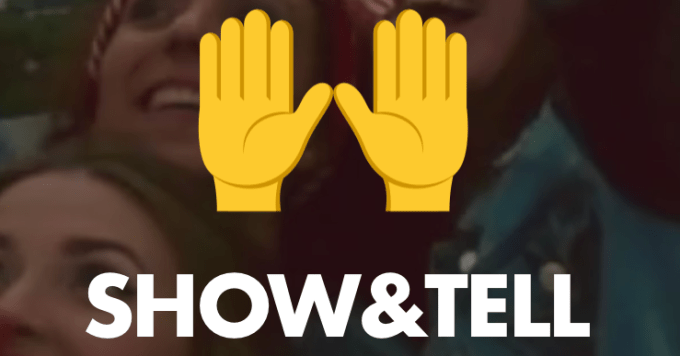 Michael Sayman was just 17 when Facebook hired him, but he’d already built 5 apps. Now 7 years after his first launch, the Facebook product manager has just released Show & Tell, which turns selfies and visual communication into a game. You’re given an emotion to act out, you send the video to friends, and they try to guess what you’re feeling. “I made 4 Snaps about… Read More
Michael Sayman was just 17 when Facebook hired him, but he’d already built 5 apps. Now 7 years after his first launch, the Facebook product manager has just released Show & Tell, which turns selfies and visual communication into a game. You’re given an emotion to act out, you send the video to friends, and they try to guess what you’re feeling. “I made 4 Snaps about… Read Moresource https://techcrunch.com/2017/02/24/show-and-tell-app/?ncid=rss
SoFi confirms $500 million in new funding as it pushes beyond lending
 Online finance startup SoFi got its start refinancing student loans but gradually has been adding other services to members. To expand into new regions and move closer to becoming a full-service financial services company, SoFi has confirmed that it raised an additional $500 million in equity financing led by Silver Lake. Read More
Online finance startup SoFi got its start refinancing student loans but gradually has been adding other services to members. To expand into new regions and move closer to becoming a full-service financial services company, SoFi has confirmed that it raised an additional $500 million in equity financing led by Silver Lake. Read Moresource https://techcrunch.com/2017/02/24/sofi-500m-silver-lake/?ncid=rss
